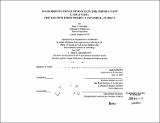| dc.contributor.advisor | Ronald Lewcock. | en_US |
| dc.contributor.author | Alamuddin, Hana S. (Hana Slieman) | en_US |
| dc.contributor.other | Massachusetts Institute of Technology. Dept. of Architecture. | en_US |
| dc.coverage.spatial | a-tu--- | en_US |
| dc.date.accessioned | 2012-06-05T13:51:51Z | |
| dc.date.available | 2012-06-05T13:51:51Z | |
| dc.date.copyright | 1987 | en_US |
| dc.date.issued | 1987 | en_US |
| dc.identifier.uri | http://hdl.handle.net/1721.1/71062 | |
| dc.description | Thesis (M.S.)--Massachusetts Institute of Technology, Dept. of Architecture, 1987. | en_US |
| dc.description | MICROFICHE COPY AVAILABLE IN ARCHIVES AND ROTCH. | en_US |
| dc.description | Includes bibliographical references (pages 113-115). | en_US |
| dc.description.abstract | This thesis examines waterfront developments in the Middle East . It concentrates on the Golden Horn project in Istanbul as it raises a number of issues that are central to any such development in that region. In order for us to appreciate the problem, the thesis starts with an examination of the history of the city of Istanbul. This is followed by an investigation of the role of the Golden Hom in its life throughout history. The main issue raised in waterfront developments in a Middle Eastern context is discontinuity between the city and the new development through the introduction of new users, functions, scale and sensibilities alien to what exists now. Istanbul, being part of an international heritage, its preservation and continuity to the water's edge becomes a moral obligation as well as a practical need to protect rest of its fabric from the repercussions of overloading. A performance specification is put forward to integrate the development back into the life of the city. Formally, urban waterfronts in the context of the Middle East are problematic as no precedent exists for dealing with the water's edge. Hence an investigation of the cultural attitude to nature and the form of the city is put forward, from which principles and orders are extrapolated to aid the designers in their approach to the problem. | en_US |
| dc.description.statementofresponsibility | by Hana S. Alamuddin. | en_US |
| dc.format.extent | 115 pages | en_US |
| dc.language.iso | eng | en_US |
| dc.publisher | Massachusetts Institute of Technology | en_US |
| dc.rights | M.I.T. theses are protected by
copyright. They may be viewed from this source for any purpose, but
reproduction or distribution in any format is prohibited without written
permission. See provided URL for inquiries about permission. | en_US |
| dc.rights.uri | http://dspace.mit.edu/handle/1721.1/7582 | en_US |
| dc.subject | Architecture. | en_US |
| dc.title | Waterfront developments in the Middle East case study : the Golden Horn Project, Istanbul, Turkey | en_US |
| dc.title.alternative | Golden Horn Project, Istanbul, Turkey | en_US |
| dc.type | Thesis | en_US |
| dc.description.degree | M.S. | en_US |
| dc.contributor.department | Massachusetts Institute of Technology. Department of Architecture | |
| dc.identifier.oclc | 16972595 | en_US |
